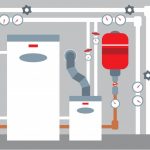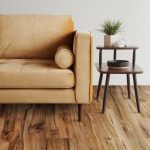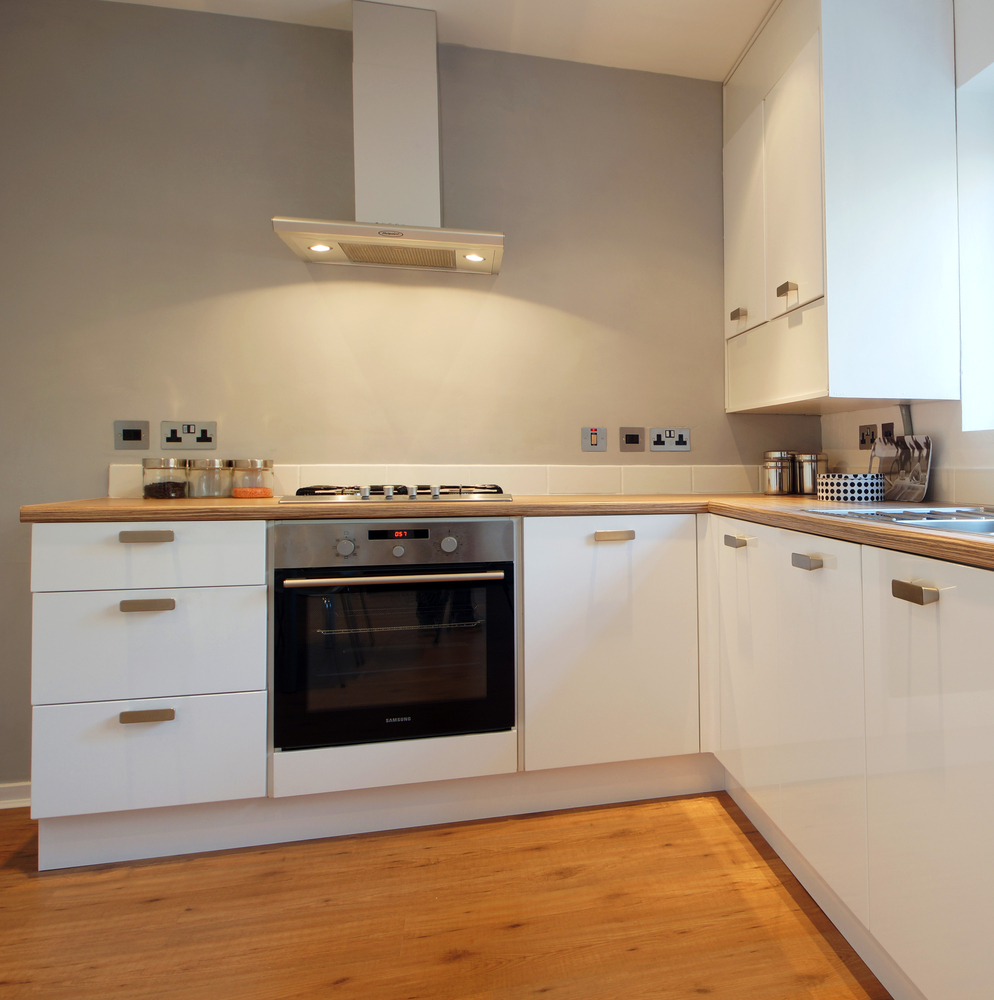As the weather warms up and seasons change, you probably start to notice significant changes in the humidity – and your floors do, too. According to the National Wood Floor Association (NWFA), the ideal humidity level in your home if you have hardwood floors should be between 30 and 50-percent.
If your home is above this humidity range, moisture and condensation can damage your hardwood flooring. Both humidity and dry air can have negative impacts on your hardwood floors and other flooring types since it encourages mold, mildew, dust mites, viruses, and bacteria to thrive. Read on to learn more about choosing the right floors for your home if you live in a humid climate.
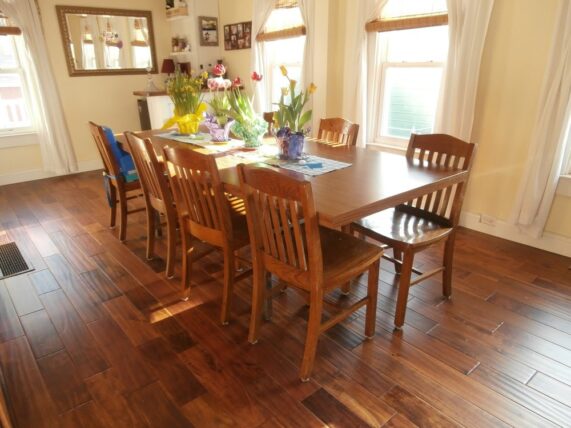
Acclimation and Conditioning
Before you install new wood floors, it needs to reach an ideal moisture content level that is in sync with the surrounding environment. This process is called hardwood acclimation, and it’s vital to ensuring that your floors don’t expand, contract, shrink, or distort which will result in improperly installed floors and potential structural damage.
Best Practices Explained
Before installing new wood floors, the relative humidity in the building should be between 30 and 50 percent, and temperatures should remain between 60 to 80 degrees Fahrenheit. The flooring itself should be kept secured indoors, and never left outside in a garage or shed where it’s exposed to the outdoor elements. Make sure that the area where you store the floors is in line with the temperature and humidity level of your home. Once the floors are delivered, check the moisture content of the material using a moisture meter. This reading will serve as the baseline to acclimate them to the environment. It’s best to measure several boards for moisture content, with an average reading of about 40 boards per 1,000 square feet. Keep your heating or air conditioning running in the home for about five days before installing the floors to give the wood time to acclimate to your living conditions.
Wood Flooring Conditions in Humid Climates Explained
It’s important to understand why and how your hardwood floors can be damaged due to humidity, and how to choose the best flooring for a humid climate.
Best hardwood flooring for high humidityIf you live in an area with high humidity, waterproof engineered hardwood is a good choice. This flooring style features several layers of pressed materials that are covered with a thin layer of real wood veneer. Since engineered hardwood is constructed of materials that are water-resistant, they do a great job at resisting warping and cupping as humidity levels change. In fact, this type of wood flooring is more stable than solid wood, which means it works well in homes or climates where the average humidity reaches 50 percent or higher. Another bonus? Engineered hardwood flooring is less expensive than solid wood floors.
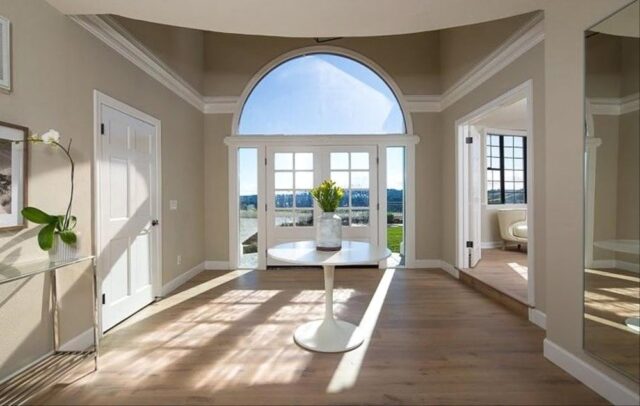
Hardwood Floor Cupping Explained
The term hardwood floor cupping refers to when your hardwood floor planks appear to be raised higher on the edges. The center of the boards appears to dip down in the center, which creates the appearance of a cup. Hardwood floor cupping occurs when there’s too much moisture in the room, causing the wood to slowly warp and change its shape as it starts to curl. Over time, the boards will need to be replaced, costing a lot of time, money, and headaches. Thankfully, cupping can be prevented with the right protective measures in place such as monitoring the humidity levels in your home or using a dehumidifier on particularly hot, humid days.
How Temperature Changes Affect Laminate Flooring
Hot temperatures and high humidity can actually have an effect on laminate flooring as well. Most laminate flooring needs to have consistent temperatures and humidity levels in order for it to look as good as possible. If you live in a region where heat is required in the wintertime, laminate floors are a good choice. Be aware that just like hardwood, laminate can rise and experience cupping just like hardwood, so always use an expansion gap when installing these types of floors. This will give them room to “breathe” as they expand and contract when humidity levels fluctuate.
When Wooden Floors Start to Buckle
It’s possible that your wood flooring will start to buckle in extremely high humidity. This occurs when your hardwood floors start to lift up and pull away from the subfloor underneath. Thankfully, buckling doesn’t occur often and typically happens if the floors have been flooded or exposed to high levels of moisture for a long period of time. If you do see your floors start to buckle, they can be repaired or certain boards can be replaced, as long as it’s caught on time. In some cases, you may need to have the floorboards removed temporarily to let air circulate underneath until everything is completely dried out.
Finding the Best Humidity Flooring Options
The best flooring for a tropical climate or a humid area depends on the material, manufacturer, and indoor moisture levels inside your home. Consult with a professional flooring installer or a flooring manufacturer to find out more about the different flooring types and their ideal moisture content levels. Use this information to help you choose the right type of flooring based on your environment.
Good Flooring Coverings for Damp/Wet Locations
Here’s some more information about the best flooring for damp or wet locations and climates.
Porcelain tile

With their durability and easy maintenance, porcelain tiles are a great water-resistant option. This flooring is perfect for damp areas of the home like a bathroom or basement, and they also work well in extremely humid climates. Not only does porcelain tile look beautiful, but it can also keep the rooms in your home cool while resisting mold and mildew. Make sure you seal the grout in between your porcelain tiles to keep them water-resistant since grout is a naturally porous material.
Ceramic Tile
Similar to porcelain, ceramic tile is rarely affected by fluctuations in humidity. As long as it’s installed correctly and on a level subfloor, your ceramic tile floors should last for many years, regardless of whether you live in a damp or wet climate. This flooring is also great for bathrooms and basements, and it requires grout which should be sealed periodically for maximum longevity.
Sheet Vinyl, Vinyl Tile, and Luxury Vinyl Flooring (LVF) Planks

Whether it’s installed as a sheet, tile, or luxury vinyl planks, this versatile material is highly waterproof and it doesn’t expand and contract as moisture and humidity levels fluctuate. This flooring material is made of PCV covered with a high-resolution photograph of wood, stone, or another type of material. This allows the vinyl to mimic the look of stone or hardwood while being much less costly and easy to install. Vinyl floors don’t grow mold or mildew, and you can replace tile or vinyl planks as needed if they ever get damaged.
Ideal Flooring Can be Obtained from BuildDirect
If you’re looking for the ideal flooring for your home, be sure to shop the selection at BuildDirect. You’ll find a variety of materials, finishes, and brands to choose from as well as decking, siding, roofing, and more. At BuildDirect, you can order free samples and have them delivered overnight. This gives you a chance to try out several colors and styles before you determine which type of flooring is right for you and your home.
Benefits of Porcelain Tile Flooring for Humid Climates
As listed above, porcelain tile is an excellent choice for flooring in humid climates. Here’s why:
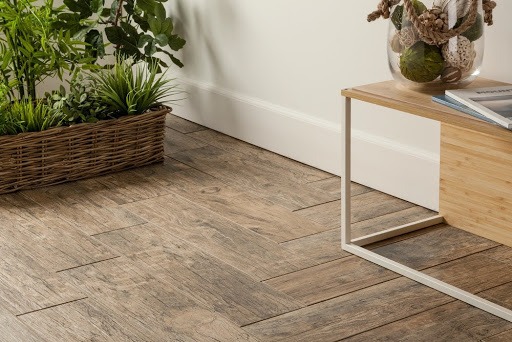
1. Moisture Resistant Tiles
Unlike certain materials like hardwood or carpet, porcelain tile has natural resistance against moisture, which makes it a perfect choice for humid climates. Since porcelain absorbs little to no moisture, it won’t warp or buckle over time, regardless of the climate or the environment in which they’re installed. An added bonus is that they do a great job of resisting stains from spills and messes if you live in a home with children or pets.
2. Durable and Longer-Lasting
Porcelain has exceptional durability, which means that your new floors will last a long time. If you’re looking for a good long-term investment for your home, porcelain tiles are the way to go. The strong material can easily handle heavy foot traffic and lots of wear and tear. Make sure you use quality grout to keep them in great condition for years to come.
3. Lower Tile Maintenance
Porcelain tile floors are easy to keep clean and easy to maintain. Simply mop or dust your floors regularly to keep them looking new. Porcelain doesn’t stain or show marks as easily as other floors, and it also doesn’t require you to reapply a sealer or sand them down and refinish them as hardwood floors do.
4. Cooling Tiles
Even if you live in a hot and humid climate, porcelain tiles are cool to the touch. In fact, installing this flooring in your home can keep the house cooler, resulting in lower electricity bills and energy savings. You can install porcelain tile outside around a pool area, too to give your feet a nice cooling sensation whenever you walk on them.
5. Vast Range of Tile Designs
If you’re aiming to create a beautiful look, porcelain tiles come in a wide range of beautiful designs. From wood-look porcelain to modern colors and unique shapes, this flooring material is a prime choice for every type of home. Look for new porcelain tile designs that will add a contemporary element to your home or try something featured in a classic colorway with a traditional design.

6. Heat Resistant Tiles
Some flooring materials like linoleum can crack when exposed to high temperatures. However, porcelain tiles are extremely heat-resistant and won’t crack after exposure to hot weather or higher temps inside your home. In fact, you can install porcelain tiles outside, too which makes them an extremely versatile choice for homes located in humid parts of the country.
Maintain Optimal Home Humidity with Laminate Flooring
If you choose to have laminate flooring installed, it’s important to be sure that your home’s humidity level remains between 30 and 60-percent at most. Anything higher than this can cause your laminate floors to become loose or damaged.
Humidity’s Effect on Laminate Flooring
If the humidity in your home goes above 60-percent, flooring starts to expand, regardless of the material. Since most laminate floors are installed using a tongue-in-groove system, the expansion pushes the sides of the planks into each other. When the sides of your laminate planks touch, they can start to buckle. Even when humidity levels are too low, it can cause issues with laminate floors. Anything under 30-percent can cause the floors to shrink and pull the planks apart, creating gaps and separation.
Preventing Flooring Damage from Humidity
Just like hardwood floors, it’s advised that you allow your laminate floors to acclimate to their environment before you install them. Lay the boxes of laminate flat and side by side, keeping them away from the edges of the wall. Give the flooring material some time to get used to the humidity in your home, which is approximately 48 hours or more. Once the flooring has been sitting inside your home for at least two days, it’s ok to install it. Leave approximately ¼-inch of room between the flooring and the wall so that your laminate can expand and contract without getting damaged.

